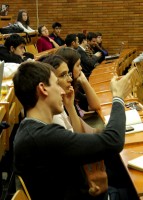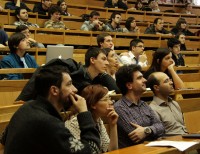
Dan Gârlașu, Sales Director within Oracle Romania joined our TechLounge Talks at Innovation Labs and talked about adapting marketing strategies to the product life cycle. Here are some brief ideas:
There were lots of products which were really successful in the beginnings and then disappeared. Take for exemple Aldus, Apollo, Ashton-Tate and Zilong which were really popular before 1990 and Novell which was popular in 2000. But even though these companies have disappeared, the people who were working for them kept on innovating.
Aldus created an application for editing documents and developed the TIF standards. In 1994 they were merged with Adobe. Three founders left Aldus to create the product later know as Microsoft Office Visio.
Ashton-Tate was the first company to realize a database product for PCs. They invented the dBASE product. Meanwhile, Clipper and Fox appeared and they were much more faster. As a result Ashton-Tate disappeared. This was possible also due to the fact that other companies developed database products.
VisiCalc was a row/column financial program. Starting from this they created Lotus 1-2-3 which was ported to the IBM PC.
Newton was the first tablet invented in 1990 and could be used as a notebook. The first smarphone was invented by IBM. Nokia and Blackberry followed.
In 1995 Netscape changed the fate of internet. It came with Mosaic made a very successful IPO with an open source product. They offered a free internet navigator tool for sustaining the e-commerce industry.
“So the internet is a group of companies with convergent interests.” said Dan Gârlașu.
Sometimes some new products change the way we do the business causing disruptive innovation. Take for example – smartphones and peer to peer networking which blew the copywrites agreements.
In Romania the first research and education network was RoEduNet. After 1993 small companies launched which were later on merged within bigger companies. Then the pragmatics got involved, the banks and the telecom companies.
“The product can have a shorter or a longer life circle, that’s why the market should be analised. You must study the clients’ profile for being able to pass all the technology adoption life cycles” said Dan Gârlașu, Oracle Sales Director
The technology adoption life cycle
 The enthusiasts – the ones who buy the products only to have it when it’s launched.
The enthusiasts – the ones who buy the products only to have it when it’s launched.
The visionaries – they see the opportunity to use that product for their interests – creating better pictures or raising money for exemple.
The pragmatics – the early majority (34%) they wait for solid arguments to use that product.
The conservators – the late majority, they accept the products only if it was proved to be useful and presents no risk.
The skeptics – they are not aware they are using the product.
Andreea Coca, Digital Qual Researched at GFK Romania has also joined the discussion and talked about market research which link a product to its users.
Steps for developing and launching a new product:
- Exploration – what we do, how we do it, for who we do this and what’s the context.
- Ideas – identify the benefits and what’s new
- Optimizations
Planning the product release:
- Market goals
- Distribution channels – where is going to be distribute and what are the methods.
- Communication – setting the communication channels
- Implementing
- Monitoring – evaluate what where the good and bad parts.
photo credit: http://infrae.com/presentations/present_OSSWATCH_osmodel/techadoption.jpg
Photos by Ioana Vasile. Notes for this article Adrian Cristea. Translated and adapted by Madalina Oprisan.





























